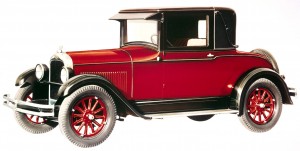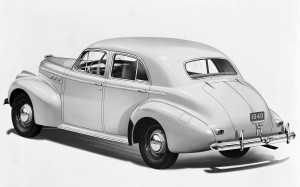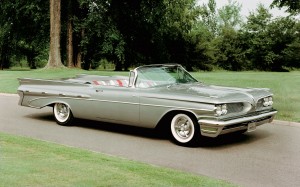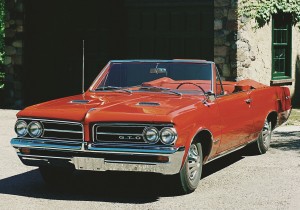
The Pontiac brand, introduced as a 1926 coupe and sedan, was Sloan's first "step up" marketing ploy.
In truth, the Pontiac brand is not yet dead; it’s only had its death sentence pronounced by General Motors, in an April 27 announcement about adjustments to its February plan for survival that was rejected by the U. S. Treasury Department. The pronouncement came after months of rumors and speculation.
In addition to announcing that Pontiac would be “phased out by the end of 2010”-20 months from now-GM said it would dispose one way or another of Saab, Saturn and Hummer by the end of this year, a mere eight months distant, in the process targeting a 42% reduction in dealer count by the beginning of 2011.
When all these cards are dealt, or dealt with, GM will still have a viable “step-up” product system with Chevrolet car and truck, Buick, GMC truck and Cadillac. Many of GM’s dealerships lately have been Pontiac-Buick-GMC and Cadillac. I’ll be willing to bet that for 2011 Buick will get some entry-level models, as they once had beginning in the Sixties, and it is conceivable they could be called Pontiacs or even have familiar Pontiac model names.
This announcement is very hard on GM people whose pride is grievously wounded whether or not they still have jobs and benefits. To the legions of Pontiac fans, especially the boomers who came of driving age just as Pontiac changed is image from stodgy to racy in the late Fifties, the news is nothing short of cataclysmic.
The Pontiac brand, introduced as a 1926 coupe and sedan, became the first major, uh, product step in Alfred P. Sloan’s strategy to create “step-up” marketing of motorcars. Notably both Pontiacs were “closed” at a time when “open” cars were still the majority of those sold, one of many “firsts” known to Pontiac enthusiasts.
Three years earlier, by means of price adjustments, Sloan had rationalized GM’s crazy quilt organization of different brands and companies acquired by founder Billy Durant starting in 1908.
In 1922, GM’s car lineup consisted of five brands: Chevrolet, priced at $510 to $1,395, Buick from $865 to $1,395, Oakland from $975 to $1,545, Oldsmobile from $1,095 to $2,145, and Cadillac from $3,100 to $4,600.
This confusing overlapping stew was corrected a year later with this lineup: Chevrolet $490 to $795, Oldsmobile $750 to $1,095, Buick Four $935 to $1,495, Oakland $945 to $1,395, Buick Six $1,275 to $2,285, and Cadillac $2,985 to $4,600. Later came product feature step-ups, a straight eight in the Buick, for instance.
But GM decided it needed an easier step-up from Chevrolet-offered then only with a four-cylinder engine–so it introduced Pontiac as a one-price ($825) model with a standard six-cylinder engine, a companion to the pricier Oakland.

From 1936 to 1956, Pontiacs generally shared GM's Built by Fisher "A" Body with Chevrolet.
After international promotion around its quintessentially American “Indian” name, it could be said that Pontiac was an overnight success, but so were Plymouth and DeSoto a couple of years later. By the depth of the Great Depression in 1932, Oakland-a Durant acquisition in 1909–was gone but Pontiac lived on in its place.
From 1936 to 1956, Pontiacs were noted for their often heavily chromed waterfall front end appearance. Generally they shared GM’s Fisher “A” Body with Chevrolet.
A flat-head straight-eight engine was added. Pontiac claimed to be first with a column shift, in 1938. For 1949 an “Indian” moniker, Chieftain, was introduced for the upper series.

The Bonneville name was for the upper series. The big deal was a two-for-one for 1959: distinctive split-grille styling still evident today, combined with "wide-track" stance.
Then Bunkie Knudsen took over in 1956 as general manager of the division–which by the way was headquartered in Pontiac, Michigan, a distant Detroit suburb-and set about changing the brand’s image. His first move was to eliminate the silver streaks over the hood. Next came souped up-engines, a speed demo and the Bonneville name for an upper series. The big deal was a two-for-one for 1959: distinctive split-grille styling still evident today, combined with “wide-track” stance.
With its performance image, Pontiac took off big time, becoming third biggest seller in the industry several times over the next three decades, with sales some years reaching almost a million, long before the industry’s 16- and 17-million years.

A rock-and-roll group, Ronny and the Daytonas, created a top selling song, written in a high school class, around the "little" GTO.
Numerous iconic model names were introduced: LeMans, Grand Prix, Firebird, Judge, Trans Am, Grand Am, 6000. Unquestionably, Pontiac in 1964 ushered in the muscle car era when it squeezed a huge 421-cid V8 into a mid-sized coupe it called GTO. It didn’t hurt that the rock-and-roll group Ronny and the Daytonas created a top selling song-written in a high school class—around it.
In 1996, Pontiac and GMC truck were merged into one organization, so that Pontiac dealers (often dualed with Buick and Cadillac) could offer trucks as they became popular as personal transportation rather than mere work vehicles.
Pontiac had some forgettable years and models, too, but they are best, well, forgotten.
So what happened to Pontiac? In the same breath, we should mention GM’s other once-highly successful brand, Oldsmobile, whose canning was announced in December 2000 but took until April 2004 to accomplish.
It’s my contention that Ford Motor’s introduction of intermediate models for 1962, on the heels of the compact cars of 1960, condemned GM’s step-up marketing money machine, but this took more than a generation to accomplish. Within a couple of years, every Detroit car brand could be bought in three different sizes (compact, mid-sized or intermediate, and standard or full-sized) whether at a Ford, Mercury, Dodge, Chrysler-Plymouth, American Motors/Rambler, Chevy, Pontiac, Olds or Buick dealer. In the early Eighties, even Cadillac succumbed with its forgettable compact Cimarron. No longer was there incentive for a buyer to move to a different brand dealership to ‘step up” to show off his success to his neighbors.
No doubt others will have different explanations, but that’s mine.
And we’ll have to see whether, if industry fortunes improve, Pontiac like the name of one of its models once, Phoenix, can rise from the ashes and be reborn.
